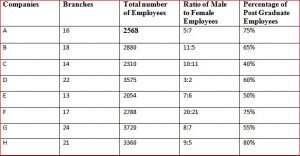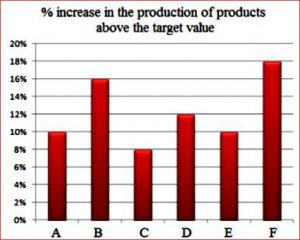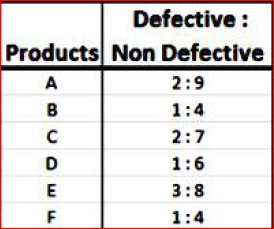Direction (1-5) Refer to the table and answer the given questions.

1)If the number of male post graduate employees in company H is 1800, what percent of the female employees in that particular company are post graduate?
A)74%
B)76%
C)75%
D)73%
E)72%
Click to View Answer
Answer A)74%
Number of Post graduate employees in Company H = 3360 *(80/100) = 2688
Number of female post graduate employees in Company H = 2688 – 1800 = 888
Required Percentage = (888 * 100)/1200 = 74%
2)In which of the given companies is the percentage of women employees with respect to the total number of employees(both males and females) in that company the second lowest?
A)G
B)B
C)E
D)H
E)D
Click to View Answer
Answer D)H
Company A : ([7/12 * (2568)] / 2568)*100 = 58.33%
Company B : ([5/16 * (2880)] / 2880)*100 = 31.25%
Company C : ([11/21 * (2310)] / 2310)*100 = 52.38%
Company D : ([2/5 * (3575)] / 3575)*100 = 40%
Company E : ([6/13 * (2054)] / 2054)*100 = 46.15%
Company F : ([21/41 * (2788)] / 2788)*100 = 51.21%
Company G : ([7/15 * (3720)] / 3720)*100 = 46.66%
Company H : ([5/14 * (3360)] / 3360)*100 = 35.71%
3) What is the ratio of the total number of male employees in companies B and H together to the total number of female employees in Companies C and D together?
A)63 : 51
B)51 : 48
C)77 : 63
D)69 : 44
E)55 : 53
Click to View Answer
Answer D)69 : 44
= [2880 * (11/16)/ 2310 * (11/21) + 3360 * (9/14)/ 3575 * (2/5)] = (1980 + 2160)/(1210 + 1430)] = 414/264 =
69:44
4) What is the difference between the average number of post graduate employees in companies A, B and D together and the average number of post graduate employees in companies F, G and H?
A)272
B)312
C)294
D)346
E)289
Click to View Answer
Answer C)294
Average number of post graduate employees in companies A, B and D = (1926 + 1872 + 2145)/3 = 5943/3 =
1981
Average number of post graduate employees in companies F, G and H = (2091 + 2046 + 2688)/3 = 6875/3 =
2275
Difference = 2275 – 1981 = 294
5) Which of the given companies has the highest number of average employees per office?
A)F
B)H
C)B
D)C
E)D
Click to View Answer
Answer D)C
Company A – 2568/16 = 160.5
Company B – 2880/18 = 160
Company C – 2310/14 = 165
Company D – 3575/22 = 162.5
Company E – 2054/13 = 158
Company F – 2788/17 = 164
Company G – 3720/24 = 155
Company H – 3360/21 = 160
A company makes a target of producing 1250 each of its 6 products A, B, C, D, E, and F in a month for selling to
its distributors. But after a month it was found that company could manufacture each product more than the
target value
The bar graph shows the % increase in the productions of each of the products. The table shows the ratio of
defective to non-defective products sold.
Study the bar graph and table to answer the questions that follow.


6) Find the total products D and E which are defective.
A) 665
B) 676
C) 542
D) 575
E) 584
Click to View Answer
Answer D) 575
First find each of the total products
A’s production is 10% above the target value of 1250.
So
A – 110/100 * 1250 = 1375
B – 116/100 * 1250 = 1450
C – 108/100 * 1250 = 1350
D – 112/100 * 1250 = 1400
E – 110/100 * 1250 = 1375
F – 118/100 * 1250 = 1475
Defective D products = 1/7 * 1400 = 200
Defective E products = 3/11 * 1375 = 375
So total = 200+375 = 575
7) Find the difference in production of products B and E together (non-defective) and production of products A and F together (defective).
A) 1615
B) 1461
C) 1254
D) 1358
E) 1225
Click to View Answer
Answer A) 1615
Non-Defective B products = 4/5 * 1450 = 1160
Non-Defective E products = 8/11 * 1375 = 1000
Defective A products = 2/11 * 1375 = 250
Defective F products = 1/5 * 1475 = 295
So required ans = (1160+1000) – (250+295) = 1615
8) Products A and B are sold for Rs 100 and Rs 120 respectively. The defective A and B products are returned to the company, how much worth of product are returned to the company?
A) Rs 62200
B) Rs 72700
C) Rs 59800
D) Rs 63100
E) Rs 34800
Click to View Answer
Answer C) Rs 59800
Defective A products = 250
Defective B products = 1/5 * 1450 = 290
So loss = 250*100 + 290*120 = Rs (25000 + 34800) = Rs 59800
9) Production of products C and E costs Rs 50 and Rs 60 respectively. They are sold for Rs 60 and Rs 80 respectively. If the defective products are returned to the company, find the loss% incurred by the company because of these products (considering that defective products are a waste for the company).
A) 4.57%
B) 4.67%
C) 5.93%
D) 3.35%
E) 5.28%
Click to View Answer
Answer B) 4.67%
CP of C products = 1350 * 50 = Rs 67500
CP of E products = 1375 * 60 = Rs 82500
So total CP of C and E = 67500 + 82500 = Rs 1,50,000
Non-Defective C products = 7/9 * 1350 = 1050
So amount got by selling these Non-Defective C products = 1050*60 = Rs 63000
Non-Defective E products = 8/11 * 1375 = 1000
So amount got by selling these Non-Defective E products = 1000*80 = Rs 80000
So total SP of Non-Defective C and E products = 63000 + 80000 = Rs 1,43000
Defective C and E products are returned, so that is a loss.
So Loss % = (150000 – 143000)/150000 * 100 = 4.67%
10) All defective products are returned to the company and also the company will have to give a penalty of Rs 5 on defective A, B and D products and Rs 6 on defective C, E and F products. Find the total penalty to be given by the company?
A) Rs 9460
B) Rs 9280
C) Rs 9840
D) Rs 9520
E) Rs 9420
Click to View Answer
Answer D) Rs 9520
Defective A products = 250
Defective B products = 290
Defective C products = 300
Defective D products = 200
Defective E products = 375
Defective F products = 295
So penalty = (250+290+200)*5 + (300+375+295)*6 = 3700 + 5820 = Rs 9520
Also Check out Quantitative Aptitude Quiz for IBPS | RRB – Set 257



















